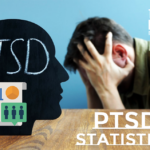Have you ever felt exhausted and stressed out right after coming back from a vacation? All of us get tired sometimes, and that’s why we need days off.
However, sometimes, even a vacation may not help. Symptoms of prolonged stress may not go away after taking a break, and you may get back to your work while still hating it.
But how can one recognize the symptoms of burnout before it’s too late, and what’s the difference between burnout and regular stress?
In this article, we will take a closer look at burnout and share some tips on how to overcome it.
Post Contents
What Is Burnout?
The most common type of burnout is work-related burnout. Work, however, isn’t the only reason why this problem may develop.
Everything that may lead to stress may also lead to burnout, which is a reason why people may experience relationship burnout or parenting burnout.
No matter what has caused burnout, it usually has certain distinctive symptoms, such as the feeling of meaninglessness, mental fatigue, and exhaustion.
Being the most common, work-related burnout can easily destroy your motivation, decrease your productivity dramatically, and turn even the easiest tasks into challenges.
While “burnout” isn’t an official psychological diagnosis, this topic has been quickly gaining popularity throughout the past 40 years.
This subject started to appear in studies at the end of the 1970s. Since then, researchers have tried to define this problem, describe it, and come up with effective ways of diagnosing it.

Burnout vs. Stress
All of us experience stress regularly, but it’s important to keep in mind that there are different types of stress which may impact your mental and physical health in different ways.
While acute stress may only cause short-term discomfort, chronic stress doesn’t let your body rest from the fight-or-flight response to an emergency or danger and restore its hormonal balance.
People with chronic stress issues may experience anxiety daily, feeling like it’s becoming more and more difficult for them to fulfill their responsibilities.
When chronic stress is caused by work, this is exactly what’s called burnout. Burnout makes you generally less engaged and driven to work, damaging your productivity and often leading to problems with not only mental but also physical health.
Symptoms Of Burnout
The main symptoms of burnout are low productivity, feelings of uselessness or thoughts about how meaningless your job is, along with mental exhaustion.
Quite often, burnout also fuels cynicism and decreases empathy. When burnt out, people often experience sleep problems, headaches, and decreased libido. Besides, chronic stress often damages one’s immunity system.
Many people confuse burnout with feeling tired so they attempt to fight it with coffee or alcohol. Unfortunately, this way, one may only worsen the symptoms of burnout.
So, it’s important to recognize burnout as early as possible. This way, you’ll be able to reach out for help and get back on track faster.
Here are some of the most common warning signs that may indicate that you’re close to burnout:
- Irritability;
- Lack of motivation and initiative;
- Self-pity;
- Escape fantasies;
- Increased procrastination;
- Mistrust of others;
- Feelings of guilt and pressure.
If you don’t receive treatment, the symptoms of burnout may become more severe and noticeable. Persistent and severe burnout may lead to:
- Depression;
- Anxiety;
- Decreased work performance;
- Suicidal thoughts;
- Relationship issues;
- Substance use disorder.
What To Do About Burnout
The most important thing you should keep in mind when dealing with symptoms of burnout is that you’re not alone.
Licensed therapists are perfectly familiar with this problem so they can help you figure out the causes of your problem and suggest effective coping practices that might be helpful in your particular case.
Talk therapy has proven to be effective when treating a vast range of mental health problems, including stress, anxiety, and depression.
Given that burnout can be caused by different factors and its symptoms can be more or less severe from person to person, therapists may choose different approaches based on an individual treatment plan. Here are some of the most common types of therapy.
Types Of Therapy For Burnout
Therapists may have different types of licenses and specializations. Although the types of therapy listed below are based on different theories, they have a lot in common because all of them imply conversations between a client and a therapist.

Cognitive Behavioral Therapy (CBT)
This is probably the most common type of therapy because it has proven to be effective when dealing with many kinds of mental health issues.
The main idea behind CBT is that unwanted emotions and behaviors are rooted in unhelpful thinking patterns. So, CBT aims to identify unhelpful thoughts and change them.
Dialectical Behavioral Therapy (DBT)
Usually, this type of therapy is used when dealing with particularly intense emotions. It’s based on CBT but it also aims to help a client develop acceptance when replacing negative thoughts is particularly difficult.
Psychodynamic Therapy
Rooted in Sigmund Freud’s psychoanalysis theory, psychodynamic therapy has evolved significantly throughout the decades and has proven to be effective when treating various mental health problems.
This type of therapy usually takes more time than CBT or DBT because instead of focusing on a single problem, it aims to address several problems at once and improve a client’s overall mental well-being.
Interpersonal Therapy
This type of therapy can be particularly useful when treating work-related burnout among people whose work involves a lot of human interaction.
For instance, doctors and police officers often experience compassion fatigue caused by constant exposure to other people’s pain and trauma.
Interpersonal therapy helps improve social skills and learn to adapt to different social situations.
How To Start Therapy
While traditional therapy has required clients to sit in the same room as their therapist, the internet changed everything and presented better opportunities.
Online therapy platforms like Calmerry allow you to get all the necessary help from virtually anywhere.
All you have to do is complete a quick questionnaire, and the platform will match you with a licensed therapist familiar with your problem within an hour.
You deserve a more fulfilling life, so don’t hesitate to ask for help!






























